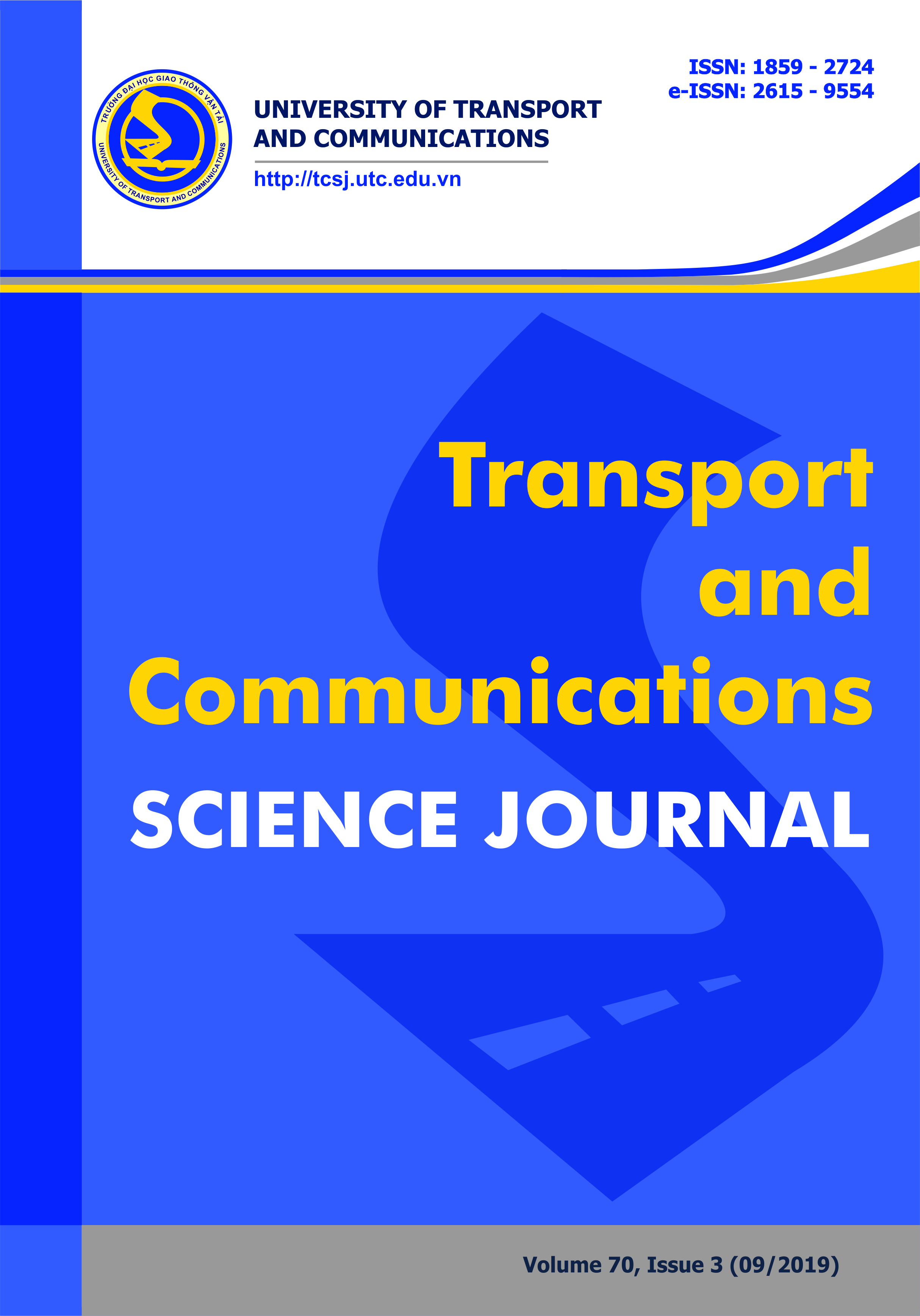An experimental and simulation study on the wet-dry action to crack cause of pier concrete in a tidal river bridge
Email:
ngodangquang@utc.edu.vn
Từ khóa:
Concrete cracks, wet–dry action, tidal river bridge, strain gradient, computer simulation.
Tóm tắt
An inspection of a tidal river concrete bridge in the Mekong River Delta discovered a large number of map cracks in most piers within the tidal range. These map cracks distribute nearly vertically and horizontally with a distance of about 15 and 20 cm. Many of them have a width over 1 mm and a depth exceeding the thickness of the reinforcement protection concrete layer. Considering the location and the pattern of cracks, the most acceptable hypothesis on their cause was the strain gradient in concrete induced by the change of moisture content during tide rise and fall, i.e. by the effect of wet – dry action. To verify this hypothesis, experiments on the time dependent change of concrete moisture content and volume were conducted. Based on the results of these experiments, a computer simulation was performed. The simulated crack map and pattern agreed very well with the observed ones. With the obtained results, it is reasonable to conclude that strain gradient in pier concrete induced by the wet – dry action may one of main causes of cracks in such bridge piersTài liệu tham khảo
[1] ACI, Causes, Evaluation and Repair of Cracks in Concrete Structures, ACI 224.1R-07, 2007.
[2] ASTM International, Standard Test Method for Density, Absorption, and Voids in Hardened Concrete - C 642 – 06, 2006.
[3] M. Bakhshi, B. Mobasher, C. Soranakom, Moisture loss characteristics of cement-based materials under early-age drying and shrinkage conditions, Construction and Building Materials, 30 (2012) 413-425. https://doi.org/10.1016/j.conbuildmat.2011.11.015
[4] Bluey Technologies Pty Ltd, Evaluating Cracking in Concrete, Australia & Asia-Pacific.
[5] Chen Gao, Tang Shen, Performance of concrete subjected to severe multiple actions of composite salts solution under wet-dry cycles and flexural loading in lab, Journal of Wuhan University of Technology-Mater. Sci. Ed., 32 (2017) 830–837. https://doi.org/10.1007/s11595-017-1676-9
[6] B. Godart, L. Divet, Lessons learned from structures damaged by delayed ettringite formation and the French prevention strategy, Fifth international conference on Forensic Engineering, Institution of Civil Engineers, France, 2013.
[7] Z. C, Grasley, D.A. Lange, Modeling Drying Shrinkage Stress Gradients in Concrete, Journal of Testing and Evaluation, 26 (2002) 115-122.
[8] P. K. Mehta, Concrete in the marine environment, Taylor & Francis e-Library, 2003.
[9] K. Sakai, Integrated Design and Environmental Issues in Concrete Technology, Taylor & Francis, 1996.
[10] Cervenka Jendele, Cervenka, ATENA Program Documentation, Prague, August 23, 2007.
[11] TCVN 6068:2004, Tiêu chuẩn quốc gia TCVN 6068:2004 về Xi măng poóc lăng bền sunphat - Phương pháp xác định độ nở sunphat, 2004. (in Vietnamese)
[12] Dinh Anh Tuan, Nguyen Manh Truong, Vietnam Academy for Water Resources (VAWR), Thực trạng ăn mòn, và phá hủy các công trình bê tông cốt thép bảo vệ bờ biển nước ta (State of corrosion and destruction of coastal reinforced concrete works in our country).
[13] G. Villain et al., Characterization of Water Gradients in Concrete by Complementary NDT Methods, International Symposium Non-Destructive Testing in Civil Engineering, Berlin, Germany 2015.
[14] Y. Wei, X. Gao, W. Hansen, Influential Depth by Water Absorption and Surface Drying in Concrete Slabs, Transportation Research Record: Journal of the Transportation Research Board, 2342 (2013) 76–82. https://doi.org/10.3141/2342-09
[2] ASTM International, Standard Test Method for Density, Absorption, and Voids in Hardened Concrete - C 642 – 06, 2006.
[3] M. Bakhshi, B. Mobasher, C. Soranakom, Moisture loss characteristics of cement-based materials under early-age drying and shrinkage conditions, Construction and Building Materials, 30 (2012) 413-425. https://doi.org/10.1016/j.conbuildmat.2011.11.015
[4] Bluey Technologies Pty Ltd, Evaluating Cracking in Concrete, Australia & Asia-Pacific.
[5] Chen Gao, Tang Shen, Performance of concrete subjected to severe multiple actions of composite salts solution under wet-dry cycles and flexural loading in lab, Journal of Wuhan University of Technology-Mater. Sci. Ed., 32 (2017) 830–837. https://doi.org/10.1007/s11595-017-1676-9
[6] B. Godart, L. Divet, Lessons learned from structures damaged by delayed ettringite formation and the French prevention strategy, Fifth international conference on Forensic Engineering, Institution of Civil Engineers, France, 2013.
[7] Z. C, Grasley, D.A. Lange, Modeling Drying Shrinkage Stress Gradients in Concrete, Journal of Testing and Evaluation, 26 (2002) 115-122.
[8] P. K. Mehta, Concrete in the marine environment, Taylor & Francis e-Library, 2003.
[9] K. Sakai, Integrated Design and Environmental Issues in Concrete Technology, Taylor & Francis, 1996.
[10] Cervenka Jendele, Cervenka, ATENA Program Documentation, Prague, August 23, 2007.
[11] TCVN 6068:2004, Tiêu chuẩn quốc gia TCVN 6068:2004 về Xi măng poóc lăng bền sunphat - Phương pháp xác định độ nở sunphat, 2004. (in Vietnamese)
[12] Dinh Anh Tuan, Nguyen Manh Truong, Vietnam Academy for Water Resources (VAWR), Thực trạng ăn mòn, và phá hủy các công trình bê tông cốt thép bảo vệ bờ biển nước ta (State of corrosion and destruction of coastal reinforced concrete works in our country).
[13] G. Villain et al., Characterization of Water Gradients in Concrete by Complementary NDT Methods, International Symposium Non-Destructive Testing in Civil Engineering, Berlin, Germany 2015.
[14] Y. Wei, X. Gao, W. Hansen, Influential Depth by Water Absorption and Surface Drying in Concrete Slabs, Transportation Research Record: Journal of the Transportation Research Board, 2342 (2013) 76–82. https://doi.org/10.3141/2342-09
Tải xuống
Chưa có dữ liệu thống kê

Nhận bài
18/08/2019
Nhận bài sửa
13/09/2019
Chấp nhận đăng
03/10/2019
Xuất bản
15/11/2019
Chuyên mục
Công trình khoa học
Kiểu trích dẫn
Ngo Dang, Q., & Mai Dinh, L. (1573750800). An experimental and simulation study on the wet-dry action to crack cause of pier concrete in a tidal river bridge . Tạp Chí Khoa Học Giao Thông Vận Tải, 70(3), 225-235. https://doi.org/10.25073/tcsj.70.3.30
Số lần xem tóm tắt
168
Số lần xem bài báo
205









